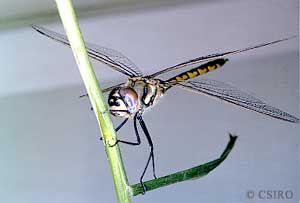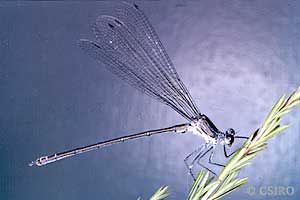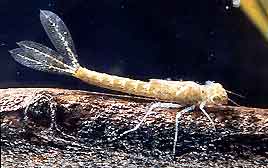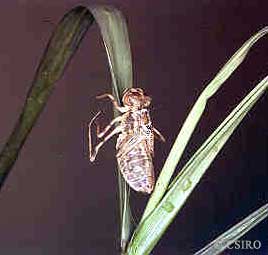|
Odonata:
dragonflies and damselflies
Characteristics
These
often brightly coloured, fast flying insects are well known and
easily recognised. Dragonflies and damselflies are medium to large
insects with body lengths ranging from 15-120 millimetres. They
are often seen flying rapidly over streams and lakes, or through
gardens at dusk, often following regular flight paths every day.
Dragonflies and damselflies can be recognised by the following features:

Nannophya dalei |
|
- Two pairs
of membranous
wings of similar shape and size
- Complex
wing venation with many cells
Damselflies
and dragonflies are very similar but can be separated by looking
at their wings. In dragonflies the hind wings are slightly broader
than the forewings and in damselflies both wings are more or less
similar size. Wings are held horizontally to the body in dragonflies
and vertically in damselflies when at rest.

Dragonfly
|
|
|

Damselfly
|
|
The nymphs
of these insects are aquatic and bear only a slight similarity to
the adults. They are wingless and have a broader more flattened
body shape. Dragonflies have gills within their body while damselflies
have 3 leaf-like gills protruding from the tip of the abdomen
(see below).
|

Damselfly Nymph
|
Life Cycle
Mating
usually takes place on the wing and the male will guard the female
as she flies along the water surface depositing her eggs. The nymph
spend almost their entire life underwater and moult
up to 15 times before they are ready to emerge.
When fully mature
the final instar crawls out onto overhanging rocks or vegetation
where they shed their last nymphal skin and emerge as an adult ready
to hunt and mate.

Dragonfly nymphal shed skin |
Development
is dependant on the species and where they live. For most species
development takes 1 to 2 years but some species that utilise temporary
water bodies grow rapidly and develop into adults after a couple
of months. Adults generally live for just a few weeks.
Feeding
Dragonflies
and damselflies are carnivorous
as both adults and nymphs.
Nymphs
feed on freshwater invertebrates catching them with specialised
mouthparts that are able to spring forward and seize prey. Adults
hunt by sight and prey on flying insects catching them on the wing
with their legs.
Habitat
Dragonflies
and damselflies are found all over Australia and although they need
water to breed, individuals can be seen flying many kilometres from
freshwater. Males tend to be territorial staying close by water
to guard their hunting and mating grounds. They can often be observed
perched on a favourite vantage point, usually a branch or rock protruding
from the water or flying rapidly across their territory. When guarding
their territory they will often fly rapidly after intruders chasing
them away before returning to the same perch.
Females often
roam further from water in search of prey. The nymphs
are predominantly aquatic, although one species in known to inhabit
wet leaf litter in northern Queensland. The nymphs
of dragonflies and damselflies can be found in many aquatic habitats
including either sluggish or fast running freshwater creeks, rivers,
stream and lakes, and some species inhabit the more saline habitats
of inland waters.
|





